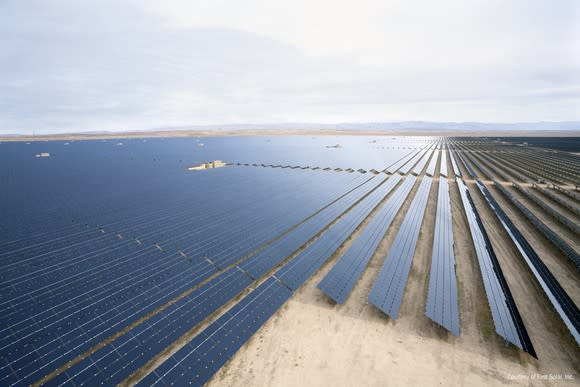Why First Solar's Price Advantage Is Gone
A year ago, First Solar Inc. (NASDAQ: FSLR) was riding high due to the threat of solar tariffs that would impact competitors but leave the costs of its wares (both domestically and internationally produced) unscathed. In early 2018, the fears of its rivals were realized when President Trump implemented tariffs on solar cell and panel imports that started with a 30% duty in 2018. First Solar was ready to take advantage, booking years of production at elevated prices, and expanding its manufacturing capacity around the world.
But as 2018 has gone on, the company's advantage has dwindled. China cut its solar incentives, which could cause installations in the world's largest solar market to shrink by 30% this year. That drop in demand is resulting in falling prices for commodity solar panels, which First Solar's panels compete directly against. Any benefit it could accrue from the U.S. tariffs may be washed away by those declining solar panel prices.

Image source: First Solar.
Competition is getting fierce
First Solar competes against other solar panel manufacturers based almost entirely on price, so it matters immensely how much their solar panels cost. Panel prices depend on factors like supply agreements, country of origin, and technology, but broadly, prices are defined by supply and demand, and we can get a broad idea of costs from industry estimates.
According to Bloomberg New Energy Finance (BNEF), the standard solar panel cost $0.37 per watt at the end of 2017. If we assume international prices didn't change when tariffs were implemented early in 2018, the net price First Solar was competing against in the U.S. was $0.48 per watt after tariffs (which was priced in for future contracts throughout 2017). Since First Solar's products weren't subject to tariffs, this $0.48 per watt number is what the company had to beat to win supply contracts in the U.S., where most of its new demand has come from in the past year.
Time Period | Price | Tariff | Net Solar Panel Price |
Q4 2017 (pre tariffs) | $0.37 per watt | n/a | $0.37 per watt |
Q4 2017 (post tariffs) | $0.37 per watt | $0.11 per watt | $0.48 per watt |
Projected 2018 with tariffs | $0.24 per watt | $0.07 per watt | $0.31 per watt |
Source: Bloomberg New Energy Finance estimate of Q4 2017 solar panel price. Calculations by the author.
When demand dropped in mid-2018, solar panel prices went with it. BNEF estimates that by the end of 2018 commodity solar panel prices will drop to $0.24 per watt. Even after a 30% tariff, that's $0.31 per watt in the U.S.
First Solar doesn't release its cost per watt or sale price for its panels, but it's competing with these commodity prices and we know that as of late 2017 management expected new panel sales contracts to generate a gross margin of over 20%. With commodity solar panel costs down 16% since then in the U.S. -- even after accounting for tariffs -- we could see significant margin pressure on future solar panel bookings.
It's no coincidence that First Solar's bookings plunged in the second quarter of 2018, given pricing trends. And if we don't see a big increase in demand and prices for commodity solar panels in the next few quarters, First Solar could face some serious pressure on margins and profitability. Unfortunately, falling margins and profitability will probably be a common story in solar over the next year.
First Solar no longer has the wind at its back, and that's starting to put pressure on its share price. The stock is down by more than 30% from its 52-week high, and if this competitive environment persists, that slide could continue. Even in the U.S., where tariffs are in place, First Solar may no longer have a competitive advantage. What we don't know yet is whether or not this is a low point in the cycle or if competing commodity solar panels will continue reducing prices. If they do, First Solar's industry-leading profitability could shrink very quickly as it works through backlog booked at high prices over the last year and a half.
More From The Motley Fool
Travis Hoium owns shares of First Solar. The Motley Fool recommends First Solar. The Motley Fool has a disclosure policy.

 Yahoo Finance
Yahoo Finance 